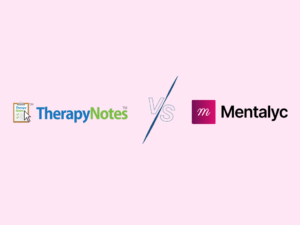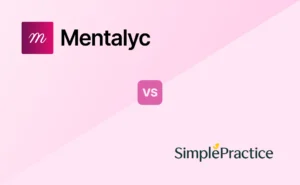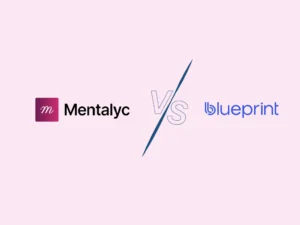The right progress note format simplifies documentation, sharpens your clinical observations, improves continuity of care, and makes reimbursement easier. As a therapist, you likely did not choose this profession to spend all your evenings buried under paperwork, but there is no doubt that progress notes are part of the deal. So, how do you find the perfect format that fits your style and meets the expectations of your client’s insurance?
This article will discuss the most common progress note formats and help you discover one that matches your voice. Choosing the right note format is not just a choice: it is an essential clinical strategy that takes care to the next level, protects your license, and gives you back the time you deserve.
Why Your Progress Note Format Matters
The structure you use influences how your insights come through, how thoroughly you document clinical concerns like safety or symptoms, and how smoothly you meet compliance or insurance expectations.
The Core Five: Popular Progress Note Formats
Here’s a look at the five most common types of therapy notes, their strengths, and when they might be a good fit.
1. SOAP (Subjective, Objective, Assessment, Plan)
- Best for: CBT therapists, insurance-heavy practices, clinicians using medical models
- Why use it: Highly structured and widely recognized across healthcare systems. Insurance companies favor it.
- Heads-up: May feel too rigid if your sessions are more narrative or free-flowing.
Example SOAP Note
- Subjective: Client reports increased anxiety before work meetings.
- Objective: Client was fidgeting and avoided eye contact.
- Assessment: Symptoms of social anxiety; client appears more dysregulated than in previous sessions.
- Plan: Introduce exposure hierarchy; assign breathing exercises.
2. DAP (Data, Assessment, Plan)
- Best for: Private practice, time-crunched clinicians, newer therapists
- Why use it: Simpler than SOAP but still effective—combines subjective + objective info.
- Heads-up: May blur data categories, which could raise red flags with supervisors or insurers.
Example DAP Note
- Data: Client described a panic attack over the weekend; appeared tearful and tense.
- Assessment: Heightened stress from work conflict; inconsistent coping skills.
- Plan: Explore triggers; reinforce grounding strategies next session.
3. BIRP (Behavior, Intervention, Response, Plan)
- Best for: High-risk clients, inpatient or IOP settings, community mental health
- Why use it: Focuses on observable behavior and clinical response—ideal for tracking risk.
- Heads-up: Can feel overly clinical or impersonal in relational therapy.
Example BIRP Note
- Behavior: Arrived late, visibly upset, expressed hopelessness.
- Intervention: Therapist used validation and cognitive reframing.
- Response: Client calmed down and said session was helpful.
- Plan: Increase check-ins to twice/week; create safety plan.
4. GIRP (Goal, Intervention, Response, Plan)
- Best for: Solution-focused or strengths-based clinicians, goal-oriented clients
- Why use it: Keeps therapy tightly connected to treatment goals—insurers like that.
- Heads-up: Might feel restrictive in exploratory sessions.
Example GIRP Note
- Goal: Reduce avoidance in social situations.
- Intervention: Role-played upcoming interaction.
- Response: Client engaged and reported lower anxiety.
- Plan: Try real-life practice; review in next session.
5. Narrative
- Best for: Psychodynamic, humanistic, or integrative therapists
- Why use it: Offers flexibility and nuance; reads like a natural session summary.
- Heads-up: Takes longer to write and may lack consistent structure.
Example Narrative Note
Today’s session centered on the client’s fear of abandonment, triggered by a recent breakup. We explored how early attachment experiences continue to shape current relationship patterns. The client showed deep emotional insight and expressed relief in connecting past and present themes.
Real-World Comparison: One Session, Three Formats
Let’s look at how the same therapy session can be documented using different formats.
Client: Age 25 with PTSD
Focus: Recurring nightmares and dissociation
SOAP:
S: Client reports three nightmares this week.
A: Signs of persistent hyperarousal.
P: Continue EMDR; increase journaling.
DAP:
D: Client reported sleep disruptions and appeared withdrawn.
A: Ongoing trauma-related symptoms.
P: Review safety plan; continue EMDR.
Narrative: The client described waking disoriented from trauma-themed dreams and growing fearful of falling asleep. Therapist validated the experience and introduced grounding tools.
Why This Matters:
Your chosen progress note format doesn’t just change how you write—it changes how you think, plan, and track client progress. These aren’t just stylistic preferences; they directly shape how your care is understood by supervisors, insurers, and even your future self. Your commitment to your chosen format directly impacts your client’s progress.
Choosing the Best Progress Note Format for Your Practice
Choosing the right progress note format is not just about staying organized—it directly impacts clinical results, insurance reimbursement, and even your energy levels at the end of the day. For mental health clinicians with heavy caseloads, delicate client work, and close deadlines, good documentation is more than just a formality. It’s a safeguard and a tool for delivering thoughtful, consistent care.
You’ve probably heard, “Just pick what works for you.” But that overlooks how frustrating, risky, and time-wasting the wrong format can be. Poor documentation can lead to denied claims, disrupt continuity of care, and cause avoidable stress; your note format shouldn’t complicate things when you’re already stretched thin.
So how do you choose?
What to Consider When Choosing a Format
Clinical Orientation & Therapeutic Style
Let your approach guide your progress note format. Cognitive-behavioral therapists may lean toward SOAP or GIRP, while narrative therapists often prefer open-ended styles that align with how they conceptualize cases.
Client Needs & Treatment Context
Working with clients in crisis? Consider BIRP for its structure. Supporting long-term insight-oriented work? Narrative or DAP might give you the room you need. The goal is always to match the format to what’s clinically relevant—not just what’s easy.
Practice or Agency Requirements
Some employers or supervisors may expect a specific progress note format. Others may give you flexibility. Even if you’re in private practice, insurance panels or legal compliance might influence your choice.
Time Efficiency & Workflow
A format that’s clinically thorough but inefficient can become a drain. DAP is often praised for its simplicity. Tools like Mentalyc can speed up documentation across formats, giving you time back without compromising quality.
Adapting Your Format as You Grow
When starting, SOAP or DAP is often the safest bet: they’re widely accepted, easy to learn, and provide helpful structure.
As you gain experience, your note style might evolve with your caseload or preferred modalities. For example, you might adopt Narrative notes for some clients or shift to GIRP if you’re doing short-term solution-focused work.
And that’s completely fine—as long as you’re consistent within each client’s chart. If you switch formats, make a quick note explaining why:
“Switching to GIRP format as of [date] to support short-term, goal-focused treatment plan.”
That clarity helps during audits and supports continuity of care over time.
One Size Doesn’t Always Fit All—And That’s Okay
Some clinicians use different formats depending on the session type or client. For example, stick with BIRP for structured agency sessions and shift to DAP or Narrative when things get more exploratory.
Again, consistency within each client record is what matters most. It’s less about rigidity and more about being intentional: choosing a format that captures your work without bogging you down.
What About Insurance?
Contrary to popular belief, insurance companies don’t mandate one specific format—but they do expect certain standards:
- Clear treatment goals
- Measurable progress
- Justified medical necessity
SOAP, DAP, and BIRP formats tend to perform best under scrutiny because they naturally capture those elements. If your claims get denied, it’s worth revisiting whether your notes connect session content to your treatment plan.
Streamlining Notes Without Sacrificing Quality
End-of-day note-taking shouldn’t drain you further. Here are a few ways to stay efficient without cutting corners:
- Use pre-filled templates for common session types
- Block 30–60 minutes daily to batch write
- Try voice-to-text tools if you think faster than you type
- Automate formatting with tools like Mentalyc
Mentalyc, for example, offers flexible templates, AI-powered summaries, and HIPAA-compliant workflows that support any note style you choose. It doesn’t box you in—it simply makes it easier to document effectively and move on with your day.
Conclusion: Your Format is an Extension of Your Clinical Voice
Your progress notes are more than a requirement – they’re an extension of your clinical voice. They show your approach to care, how you think about your client’s needs and how you advocate for their progress. The right format can make your documentation easier, clearer and your clinical insights sharper. But there’s no one “right” format. It’s about finding what works for you and your clients. Whether you use SOAP, DAP or another structure, consistency is key. Stick with what captures the important information clearly and accurately and don’t be afraid to try new things until you find your rhythm.
If you’re ready to find a format that fits or streamlines the one you already use, Mentalyc can help. With flexible templates, AI-powered summaries, and support for every significant note style, Mentalyc is designed to work with your clinical judgment—not override it. Think of Mentalyc as a co-pilot for your notes, helping you document efficiently while staying true to your practice.
Because when your documentation works with you, not against you, it gives you back the energy to do the work that matters most: showing up fully for your clients.
Progress Note Formats: FAQs on Choosing the Right Approach
As a therapist, selecting the best progress note format can be overwhelming. Let’s address some frequently asked questions to help you navigate this critical aspect of your practice.
What is the “best” note format for therapy?
It’s not a single model for everyone. Your clinical style, client population, and documentation needs will determine the best choice. SOAP and DAP are commonly used because of their structure and adaptability, but BIRP, GIRP, and Narrative notes may be better suited to certain types of therapy or settings.
How do I know if my current format is effective?
Ask yourself: Does this format enable me to take notes effectively and briefly? Am I consistently jotting down the information required—like progress, risk factors, and changes in treatment—without feeling overwhelmed? If not, then it might be time to look for alternatives.
Can I switch formats if I’ve already developed a habit?
Yes, the majority of clinicians refine their documentation pattern with time. Make sure to be consistent with each client’s record and introduce changes in case they are required with your supervisor or agency. A more appropriate format can reduce burnout and improve documentation quality.
What formats do insurance companies prefer?
Insurers don’t provide a specific format, but they do require clarity, measurable results, and treatment justification. SOAP, DAP, and BIRP are commonly accepted since they organize notes regarding clinical findings and treatment objectives.
Can AI solutions like Mentalyc help with different formats?
Yes. Mentalyc is designed to support several progress note styles—i.e., SOAP, DAP, BIRP, GIRP, and Narrative—so you may choose the best style. It simplifies documentation without limiting your clinical voice or professional integrity.
What if I work in more than one setting or have multiple client styles?
It is acceptable to modify your note-writing style to fit the environment. Just try to be consistent inside a case file. For example, you can use SOAP to work with one individual and a narrative style with repeated trauma.
Resources
BehaveHealth. (2025, February 17). Mental Health Progress Notes: Best Practices.
Fisher-Caudill, L. (n.d.). Therapist’s Guide for Writing Session Notes for Insurance Documentation – As quickly as possible! Therapy Reflections.
Leora Behavioral Health. (2025, May 2). The Importance of Documenting Therapy Progress Accurately.
Notenest. (2025, March 6). The Art of Therapy Notes: Enhancing Client Progress with Clear Documentation.
Qualifacts. (2024, April 1). An Overview of Mental Health Notes and Their Uses.
Todrick, J. (2024, February 12). Understanding the differences between DAP, SOAP, and BIRP notes. Ensora Health.
University of Minnesota. (n.d.). Why Consistent Therapy Notes Matter for Client Success.
Why other mental health professionals love Mentalyc

“Having Mentalyc take away some of the work from me has allowed me to be more present when I’m in session with clients … it took a lot of pressure off.”
LPC

“It takes me less than 5 minutes to complete notes … it’s a huge time saver, a huge stress reliever.”
Licensed Marriage and Family Therapist

“A lot of my clients love the functionality where I can send them a summary of what we addressed during the session, and they find it very helpful and enlightening.”
Therapist

“By the end of the day, usually by the end of the session, I have my documentation done. I have a thorough, comprehensive note … It’s just saving me hours every week.”
CDCII







